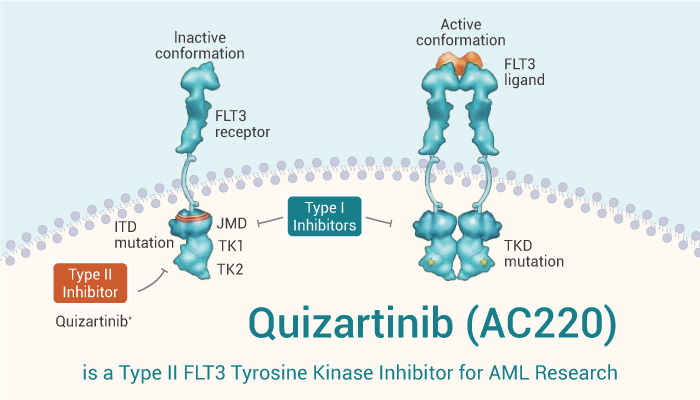FLT3 (Fms-like tyrosine kinase 3, CD135) is a cytokine receptor which belongs to the receptor tyrosine kinase class III. Besides, FLT3 is important for the normal development of stem cells and the immune system. Importantly, FLT3 CD135 is a proto-oncogene, meaning that mutations of this protein can lead to cancer. Particullary, Mutations of the FLT3 receptor can lead to the development of leukemia, a cancer of bone marrow hematopoietic progenitors. Moreover, Internal tandem duplications of FLT3 (FLT3-ITD) are the most common mutations associated with acute myelogenous leukemia (AML) and are a prognostic indicator associated with adverse disease outcom.

Quizartinib is an orally active, highly selective and potent FLT3 tyrosine kinase inhibitor for AML research.
Quizartinib (AC220) is a potent second-generation type II FLT3 tyrosine kinase inhibitor, with a Kd of 1.6 nM. Besides, Quizartinib inhibits wild-type FLT3 and FLT3-ITD autophosphorylation in MV4-11 cells with IC50s of 4.2 and 1.1 nM, respectively. In addition, Quizartinib shows antiproliferative activity with IC50s of 0.56, >10000 nM for MV4-11, A375 cells, respectively. Meanwhile, Quizartinib (10 mg/kg; p.o.; once) shows good pharmacokinetic properties with Cmax of 3.8 µM, Tmax of 1.5 h and AUC0-24 h of 35 μM×h in Female NU/NU mice. Additionally, Quizartinib (0.1, 1, 10 mg/kg; p.o.; once a day for 30 days) prolonged survival in a dose-dependent manner with no obvious toxicity or body weight loss in an MV4-11 xenograft model.
Quizartinib can be linked to the VHL ligand via an optimized linker to form a PROTAC FLT3 degrader. However, This PROTAC displays a low nanomolar degradation concentrations of FLT3-ITD in MV4-11 and MOLM-14 cells, and the cell growth inhibition activity was >3.5-fold more potent than quizartinib (IC50 of 0.6 nM).
All in all, Quizartinib is an orally active, highly selective and potent second-generation type II FLT3 tyrosine kinase inhibitor for AML research.
Reference:
[1] Zarrinkar PP, et al. Blood. 2009 Oct 1;114(14):2984-92.
[2] Sun X, et al. Signal Transduct Target Ther. 2019 Dec 24;4:64.